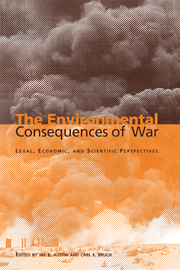Book contents
- Frontmatter
- Contents
- List of illustrations
- List of tables
- List of contributors
- Acknowledgements
- Foreword by Klaus Toepfer
- Introduction
- Part I General principles
- Part II The legal framework
- Part III Assessing the impacts – scientific methods and issues
- Introduction
- 11 Scientific assessment of the long-term environmental consequences of war
- 12 The Gulf War impact on the terrestrial environment of Kuwait: an overview
- 13 War-related damage to the marine environment in the ROPME Sea Area
- 14 War and biodiversity: an assessment of impacts
- Introduction
- 15 Tracking the four horsemen: the public health approach to the impact of war and war-induced environmental destruction in the twentieth century
- 16 Defoliants: the long-term health implications
- 17 The impact of military preparedness and militarism on health and the environment
- 18 War and infectious diseases: international law and the public health consequences of armed conflict
- Part IV Valuing the impacts – economic methods and issues
- Part V Prospects for the future
- Index
17 - The impact of military preparedness and militarism on health and the environment
Published online by Cambridge University Press: 04 August 2010
- Frontmatter
- Contents
- List of illustrations
- List of tables
- List of contributors
- Acknowledgements
- Foreword by Klaus Toepfer
- Introduction
- Part I General principles
- Part II The legal framework
- Part III Assessing the impacts – scientific methods and issues
- Introduction
- 11 Scientific assessment of the long-term environmental consequences of war
- 12 The Gulf War impact on the terrestrial environment of Kuwait: an overview
- 13 War-related damage to the marine environment in the ROPME Sea Area
- 14 War and biodiversity: an assessment of impacts
- Introduction
- 15 Tracking the four horsemen: the public health approach to the impact of war and war-induced environmental destruction in the twentieth century
- 16 Defoliants: the long-term health implications
- 17 The impact of military preparedness and militarism on health and the environment
- 18 War and infectious diseases: international law and the public health consequences of armed conflict
- Part IV Valuing the impacts – economic methods and issues
- Part V Prospects for the future
- Index
Summary
Introduction
For the most part, the chapters in this volume address the impacts of the waging of war on the environment and on health. Several of the other authors have broadened their considerations to include the environmental impact of both war and preparations for war. For example, Arthur Westing, in his discussion of environmental guidelines for armed forces, considers guidelines for both wartime and peacetime. Asit Biswas, in analyzing the problem of assessing the long-term environmental consequences of war, considers the effects of the use of resources by military forces during both war and peace. These chapters illustrate the difficulties inherent in attempting to draw artificial distinctions between the environmental consequences of military operations during war and of military operations during peacetime. While it may be useful in legal analysis to distinguish environmental and health problems caused by war from those caused by preparations for war, to those concerned with public health these distinctions have little meaning. This chapter addresses two separate but closely related topics: the impact on the environment and on health of military preparedness and of militarism itself.
Further, it may at times be difficult to distinguish the health and environmental consequences of some forms of military preparedness from the consequences of war itself. The worst chemical weapons disaster of World War II was caused by the explosion of the US merchant ship John Harvey, which was carrying 100 tons of mustard gas during a German bombing raid of Bari, a port on the coast of Italy. More than 1,000 military personnel, and an even larger number of civilians, lost their lives as a result of the explosion.
- Type
- Chapter
- Information
- The Environmental Consequences of WarLegal, Economic, and Scientific Perspectives, pp. 426 - 443Publisher: Cambridge University PressPrint publication year: 2000
- 4
- Cited by



